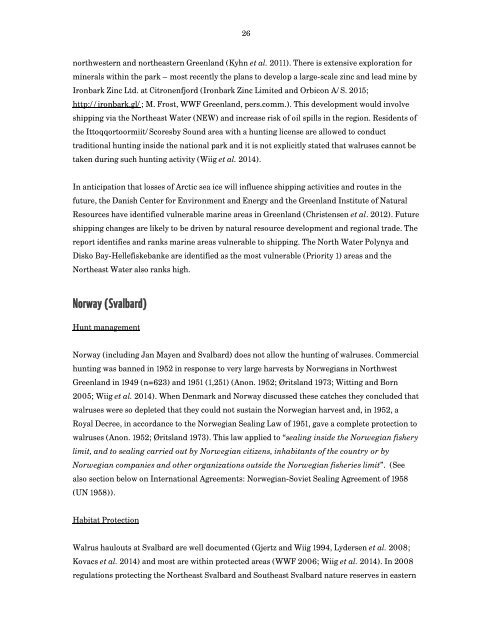The State of Circumpolar Walrus Populations
walrusreport
walrusreport
You also want an ePaper? Increase the reach of your titles
YUMPU automatically turns print PDFs into web optimized ePapers that Google loves.
26<br />
northwestern and northeastern Greenland (Kyhn et al. 2011). <strong>The</strong>re is extensive exploration for<br />
minerals within the park – most recently the plans to develop a large-scale zinc and lead mine by<br />
Ironbark Zinc Ltd. at Citronenfjord (Ironbark Zinc Limited and Orbicon A/S. 2015;<br />
http://ironbark.gl/; M. Frost, WWF Greenland, pers.comm.). This development would involve<br />
shipping via the Northeast Water (NEW) and increase risk <strong>of</strong> oil spills in the region. Residents <strong>of</strong><br />
the Ittoqqortoormiit/Scoresby Sound area with a hunting license are allowed to conduct<br />
traditional hunting inside the national park and it is not explicitly stated that walruses cannot be<br />
taken during such hunting activity (Wiig et al. 2014).<br />
In anticipation that losses <strong>of</strong> Arctic sea ice will influence shipping activities and routes in the<br />
future, the Danish Center for Environment and Energy and the Greenland Institute <strong>of</strong> Natural<br />
Resources have identified vulnerable marine areas in Greenland (Christensen et al. 2012). Future<br />
shipping changes are likely to be driven by natural resource development and regional trade. <strong>The</strong><br />
report identifies and ranks marine areas vulnerable to shipping. <strong>The</strong> North Water Polynya and<br />
Disko Bay-Hellefiskebanke are identified as the most vulnerable (Priority 1) areas and the<br />
Northeast Water also ranks high.<br />
Norway (Svalbard)<br />
Hunt management<br />
Norway (including Jan Mayen and Svalbard) does not allow the hunting <strong>of</strong> walruses. Commercial<br />
hunting was banned in 1952 in response to very large harvests by Norwegians in Northwest<br />
Greenland in 1949 (n=623) and 1951 (1,251) (Anon. 1952; Øritsland 1973; Witting and Born<br />
2005; Wiig et al. 2014). When Denmark and Norway discussed these catches they concluded that<br />
walruses were so depleted that they could not sustain the Norwegian harvest and, in 1952, a<br />
Royal Decree, in accordance to the Norwegian Sealing Law <strong>of</strong> 1951, gave a complete protection to<br />
walruses (Anon. 1952; Øritsland 1973). This law applied to “sealing inside the Norwegian fishery<br />
limit, and to sealing carried out by Norwegian citizens, inhabitants <strong>of</strong> the country or by<br />
Norwegian companies and other organizations outside the Norwegian fisheries limit”. (See<br />
also section below on International Agreements: Norwegian-Soviet Sealing Agreement <strong>of</strong> 1958<br />
(UN 1958)).<br />
Habitat Protection<br />
<strong>Walrus</strong> haulouts at Svalbard are well documented (Gjertz and Wiig 1994, Lydersen et al. 2008;<br />
Kovacs et al. 2014) and most are within protected areas (WWF 2006; Wiig et al. 2014). In 2008<br />
regulations protecting the Northeast Svalbard and Southeast Svalbard nature reserves in eastern


